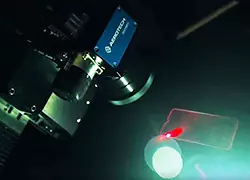In the world of high-tech manufacturing and advanced research, the demand for repeatable, precise motion is absolute. While linear motion is often discussed, precise angular positioning is equally critical, enabling systems to align sensors, inspect complex optics or orient workpieces with sub-arc-second fidelity. The motorized rotation stage is the device engineered to perform this essential task automatically, reliably and quickly.
To understand the core mechanics and superior performance that define these systems, refer to our detailed guide on the high precision rotary stage. The need for automated rotational control is a fundamental requirement across the spectrum of precision stages and is a key factor in improving throughput and accuracy across all automated systems.
What Is a Motorized Stage?
A motorized stage is a platform that moves automatically along one or more axes using an integrated motor, allowing precise, repeatable positioning. Unlike manual stages that rely on human observation and adjustment, a motorized stage converts electrical energy into controlled mechanical movement directed by a central controller. This inherent automation eliminates human error and vastly increases the speed and consistency of positioning routines. The stage platform provides a stable mounting surface for the payload, be it an optical component, a sensor or a workpiece.
The core advantage of a motorized stage is its integration into a closed-loop control system. This system constantly measures the stage's actual position via an encoder or sensor, comparing it to the commanded position and making real-time adjustments. This dynamic error correction is essential for achieving the nanometer and microradian level accuracy demanded by modern applications. It is commonly used in automation, microscopy and precision motion applications where manual adjustment is impractical due to the required speed, complexity or level of precision. Furthermore, motorized stages can be easily programmed to execute complex motion profiles, including coordinated movement across multiple axes.
How Do Motorized Rotation Stages Work?
Motorized rotation stages use a motor—typically stepper, servo or direct-drive—to rotate a platform around a fixed axis. The motor is the actuator, providing the necessary torque to overcome the inertia and friction of the load. Stepper motors are often used for lower cost, open-loop positioning, while servo motors provide closed-loop dynamic performance. Direct-drive motors, which have no mechanical contact, offer the highest speed and zero-backlash operation, making them the preferred choice for ultra-high motorized rotation stage performance.
The motor’s motion is transmitted through gears, belts or directly to the drive shaft, and measured using a feedback device such as an optical encoder, allowing precise, controllable rotation with high repeatability and accuracy. Gear-driven stages use a worm gear to achieve high resolution and self-locking capability, ideal for holding a position rigidly. Direct-drive stages bypass mechanical transmission entirely, connecting the motor rotor directly to the platform. The optical encoder provides position feedback in high-resolution increments, often down to sub-arc-second levels. This feedback signal is processed by the controller, which uses sophisticated algorithms to ensure the stage reaches and maintains the commanded angular position with flawless fidelity.
How Do You Choose a Motorized Rotation Stage?
Selecting the optimal stage requires a rigorous technical evaluation to match the stage's capability with the application's demands. Choose a motorized rotation stage by evaluating your application’s load capacity, required torque, speed and angular resolution. Load capacity must account for the mass and distribution of the payload, which determines the crucial moment of inertia. The required torque must be sufficient to accelerate the load to the desired speed and maintain it against friction. Angular resolution and accuracy must meet the minimum positioning requirements of the process.
Also consider drive type, range of motion and compatibility with your control system to ensure accurate and reliable performance. Direct-drive stages are preferred for dynamic, high-speed applications, while gear-driven stages might be chosen for their self-locking and high-resolution positioning capability over small angular ranges. The stage's physical size and clear aperture requirements must also be verified. Consulting an experienced motion supplier for the best results is crucial. They can assist with complex torque and inertia calculations, ensuring the chosen motorized rotation mount and drive system are perfectly matched to your motion profile.
What Are Motorized Rotation Stages Used For?
Motorized rotation stages are used for precise angular positioning in applications like optics, photonics, microscopy and metrology. These stages provide the highly repeatable angular movement necessary for the most complex scientific and industrial processes. They enable automated, repeatable rotation for alignment, inspection and testing tasks where manual adjustment would be slow or inaccurate. For instance, in silicon photonics, they align optical fibers to waveguides with sub-microradian precision. In inspection, they precisely rotate a component for 360-degree quality checks.
Commonly used in laboratories for optical experiments and imaging applications, they allow researchers to automate precise manipulations. Essential in automation processes for manufacturing and assembly lines, they serve as highly accurate rotary tables, indexing parts for welding, drilling or vision inspection. A high-performance rotary table can perform motion simulation, replicating environmental dynamics for testing sensors, gyroscopes and inertial navigation systems. The ability to program complex, synchronized motion makes these motorized platforms indispensable across all areas of advanced production and research.
Ready to dive deeper into the world of precision stages?


